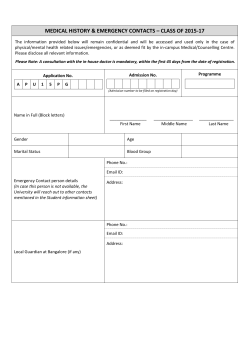
The stages of change The Prochaska
Introduction to behavioral medicine: Lifestyle and health The stages of change: The Prochaska-DiClemente model Eszter Tisljár-Szabó Department of Behavioral Sciences eszter.szabo@sph.unideb.hu • Course organizer: Mónika Andrejkovics andrejkovics.monika@sph.unideb.hu • Homepage: mti.deoec.com • Log-in name: NKstudent • password: magatartas Biomedical model (19th century) Bio-psycho-social model (20th century) Health psychology, behavioral medicine What causes illness? Illnesses come from outside the body Illness is caused by multitude factors: biological, psychological, and social factors Who is responsible for illness? Individual is not responsible, they are victims Individual may be held responsible for their health and illness How should illness be treated? With vaccination, sugery, chemotherapy etc., to change the physical state of the body The whole person should be treated (bio-psycho-social) Who is responsible for treatment? The medical profession The patient is in part responsible What is the relationship between the mind and the body? The funcion independently of each other There is an interaction between the two What is the role of psychology in health and illness? Illness may have psychological consequences but no psychological causes Illness can not only have psychological consequences but psychological causes as well. Ogden, 2007, p 4 The role of behavior 75% of all death due to cancer are related to behaviour (Doll&Peto, 1981) other factors 25% tobacco tobacco 30% sexual behaviour alcohol 7% 3% poor diet 35% alcohol poor diet sexual behaviour other factors • McKeown: 50% of mortality from the ten leading causes of death is due to behavior Health behavior seem to be important in predicting mortality and the longevity of individuals research and models to understand and predict health-related behaviors. One of these is the stages of change model (Prochaska&DiClemente, Nocross) Nonadherence is present • around 40% of patients don’t follow the treatment plans • this number doubles when plans are complicated and/or require lifestyle changes What’s wrong? – Repeated education is often not successful + frustrated – Promising an improved outcome is not enough – Confrontational = critical – Relapse = failure giving up + avoid contact with physician A typical interview http://www.youtube.com/watch?v=80XyNE89eCs The ‚Stages of Change’ Approach (Prochaska, DiClemente, Norcross) Motivational interviewing (Rollnick, Miller) http://www.womentowomen.com/womenshealth/howtomakelifechanges.aspx Contemplation Preparation Action Maintenance Not thinking about change May be resigned Feeling of no control Denial: does not belive it applies to self Belives consequences are not serious I am happy being a smoker and intend to continue smoking. •Considering a change •Weighing benefits and cost of behavior •I have been coughing a lot recently, perhaps I should think about stopping smoking. • Experimenting with small changes • I will stop going to the pub and will buy lower tar cigarettes. • Taking a definitive action to change • I have stopped smoking. • Maintaining new behavior over time • I have stopped smoking for four month now. RELAPSE Precontemplation • • • • • • Interventions based on the Stages of Change model motivational inteview • First step: identifying the patients position in the change process • Focus of the visit: help the patient move along the stages = Identify the stage of change and engage patient in a process to move to the next step • As a start: – brief and simple advice = opening assessment of where the patient is in the behavior change process • developing and maintaining positive relationship, • personalizing risk factors, • posing questions that provoke thoughts about risk factors • Reflect with empaty • Gently point out discrepancies between goals and statements Considering benefits and disadvantages Decisional balance sheet Benefits of the present behavior Disadvantages of the present behavior Reduces anxiety Feels good Together with the others Costs a lot Takes time Not anymore fancy Stinky fingers Disadvantages of change Benefits of change Temporary mood change Irritability Gaining weigth Drop out of the gang Saving money Healthier life, less illnesses Better physical fittness My children like me better Relapse is common!!! Explain that even though a relapse, „it is best to avoid smokethey have learned something new filled environments” about themselves and about the process of changing behavior Focus on the successful part of the „you did it for six days; what plan made that work?” Support patients and re-engage their efforts in the change process! The effective interview http://www.youtube.com/watch?v=URiKA7CKtfc Used literature Ogden, J. (2007) Health Psychology: A Textbook. Maidenhead, Open University Press. Zimmermann et al. (2000) A Stages of Change Approach to Helping Patients Change Behavior. American Family Physician, 61, 5.
© Copyright 2025













